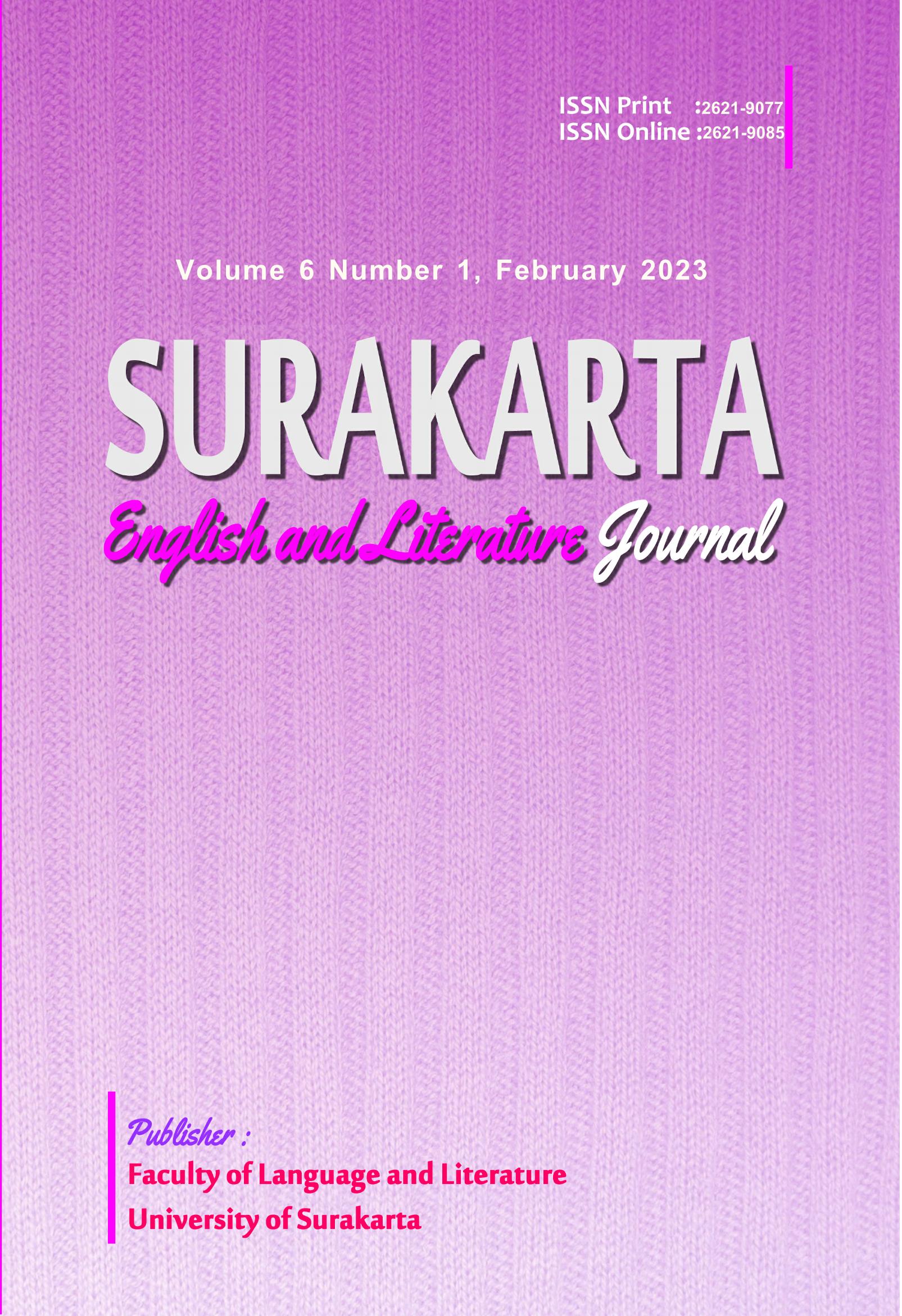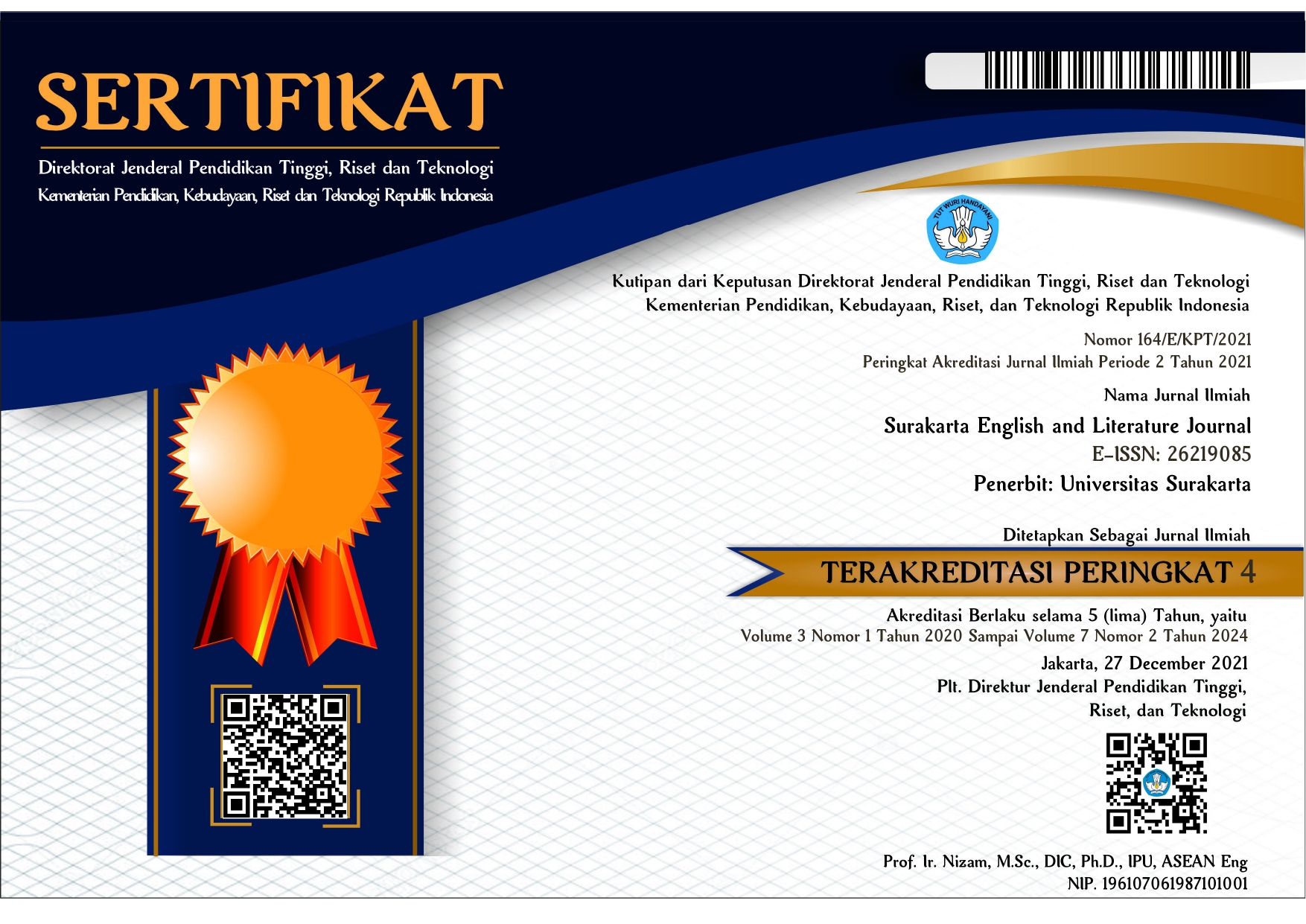The Archetypal Symbols and The Hero’s Journey of Alice in Wonderland Film
DOI:
https://doi.org/10.52429/selju.v6i1.112Keywords:
myth, hero’s journey, archetype symbol, filmAbstract
Myth is a classic story about heroes who explain the origins of natural occurrences. Myth is not always given historically since the modern one will continue to evolve and impact cinema creation. This study aimed to look at the categorization of Campbell's "hero's journey" and the archetypal symbols under Segal's theory, as provided by the main character in the Alice in Wonderland film. The data for this study was taken from a plotline in Woolverton's Alice in Wonderland. The study's findings suggested that the film had a tight relationship with a myth. The primary characters, including Alice, the Red Queen, and the White Queen, symbolized archetypal emblems of light and evil. Alice could eventually complete the hero's journey, beginning with departure, reaching a climax in the initiation stage, and reaching the return stage as the significant point of the movie's plot and the same fundamental structure in the myths.
References
Ary, Donald; Jacobs, L.C.; Sorensen, C. (2010). Introduction to Research in Education (Eight Edit). Wadsworth Cengage Learning.
Bernhardt, W. (2013). Perfecting Plot. Charting the Hero’s Journey. Babylon Book.
Bloom, H. (2009). Bloom’s Literary Themes. The Hero’s Journey. Infobase Publishing.
Bogdan, R. C., & Biklen, S. K. (2007). Qualitative research for education: an introduction to theories and methods.
Cahyaningrum, I. O. (2018). Psychological Literature Translation. Surakarta English and Literature Journal, 1(1), 31. https://doi.org/10.52429/selju.v1i1.205
Campbell, J. (2008). The Hero with a Thousand Faces. Princeton University Press. https://doi.org/10.2307/j.ctvqr1bhz.37
Dickerson, M.& O’Hara, D. (2006). From Homer to Harry Potter: A Handbook on Myth and Fantasy. Brazos. https://doi.org/10.35672/jnus.v3i1.1-21
Fina, A, D. and Georgakopoulou, A. (n.d.). The Handbook of Narrative Analysis. Wiley-Blackwell.
Hochenedel, H. N. nd. (2012). Alice in Wonderland: A Heroine’s Quest for Self. http://home.comcast.net/~crapsonline/alice.html
Josselson, R. (2011). Narrative research: constructing, deconstructing and reconstructing story. Guilford Press.
Kasdan, M.A., Saxton, C., and Tavernetti, S. (1993). The Critical Eye. An Introduction to Looking at the Movies. Kendall/Hunt Publishing Company.
Lehman, P. and Luhr, W. (2018). Thinking about Movies. Watching, Questioning, Enjoying.
Lutwidge, C. (1898). Alice ’ s Adventures In Wonderland by Lewis Carroll , 1832-1898. Глава I, 1–27.
Metzareph. (2005). Qabalistic Alice in Wonderland and the Depths of Hell. Temple of Thelema: A Mystery School of the New Aeon. http://www.heruraha.net/viewtopic.php?f=20&t=25.
Monomyth: Hero’s Journey Project. (n.d.). In Berkeley ORIAS. https://orias.berkeley.edu/resources-teachers/monomyth-heros-journey-project
Robson, M. (2020). What is Literature? A Critical Anthology. Wiley-Blackwell.
Rush, C. (2008). The Threshold of Adventure. https://apocprod.com/Pages/Hero/Hero_Diagram_Pages/threshold_of_adventure.htm
Sarbin, T. (1986). ‘The narrative as root metaphor for psychology’, in T. Sarbin (ed.) Narrative Psychology: The Storied Nature of Human Conduct. Praeger.
Segal, R. A. (1998). Jung on Mythology. Encountering Jung. Princeton University Press.
Smith, E. L.& Brown, N. R. (2007). The Complete Idiot’s Guide to World Mythology: Timeless Tales and legends from Every Corner of The Globe. Alpha.
Sugeng, M., Retnaningdyah, P., & Mustofa, A. (2019). The Reflected Mythological Patterns on Researchers’ Journey through Literacy Narratives. NOBEL: Journal of Literature and Language Teaching, 10(1), 15–31. https://doi.org/10.15642/nobel.2019.10.1.15-31
The Aeclectic Tarot. (n.d.). The Fool. http://www.aeclectic.net/tarot/learn/meanings/fool.shtml.
Viega, M. (2017). From Orphan to Sage: The Hero’s Journey as an Assessment Tool for Hip Hop Songs Created in Music Therapy. Journal of Genius and Eminence, 2(Volume 2, Issue 2: Winter 2017), 78–87. https://doi.org/10.18536/jge.2017.02.2.2.08
Wolde, E. V. (1989). A Semiotic Analysis of Genesis 2-3. A Semiotic Theory and Method of Analysis Applied to the Story of the Garden of Eden. Van Gorcum & Comp.
Wormeli, R. (2009). Metaphors & Analogies. Power Tools for Teaching Any Subject. Stenhouse Publishers.

Downloads
Published
How to Cite
Issue
Section
License
Copyright (c) 2023 Rohmatul Fitriyah Dewi, Darini Yusrina A

This work is licensed under a Creative Commons Attribution-ShareAlike 4.0 International License.
Licensing for Data Publication
-
Open Data Commons Attribution License, http://www.opendatacommons.org/licenses/by/1.0/ (default)
-
Creative Commons CC-Zero Waiver, http://creativecommons.org/publicdomain/zero/1.0/
-
Open Data Commons Public Domain Dedication and Licence, http://www.opendatacommons.org/licenses/pddl/1-0/













